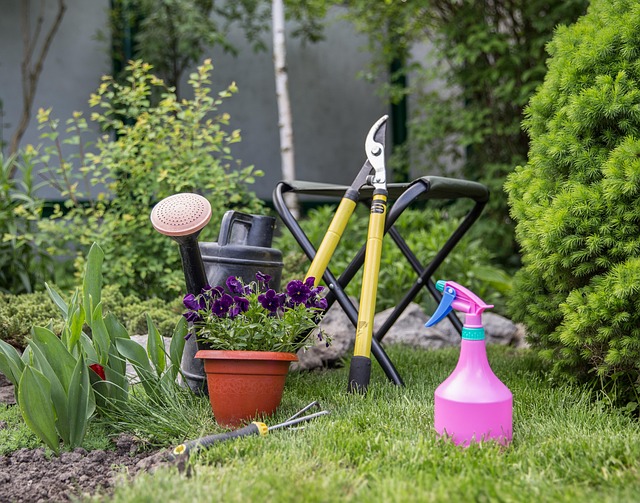Mulching and fertilizing are essential year-round backyard upkeep tips for robust plant health. Mulch protects soil, retains moisture, blocks sunlight to suppress weeds, and enriches soil with organic nutrients. Fertilizers cater to plants' unique nutrient needs, with organic options promoting roots and long-term fertility. Strategic application in spring, summer, autumn, and winter—including balanced fertilizers, slow-release formulas, and pH adjustments—ensures thriving vegetation. Consistent care like weeding, watering, and pest monitoring completes these backyard upkeep tips for a vibrant, healthy yard.
“Enhance your backyard’s health and beauty with year-round mulching and fertilizing strategies. This comprehensive guide unveils the secrets to establishing a robust garden ecosystem. From understanding the foundational role of mulching in retaining moisture and suppressing weeds to selecting the perfect fertilizer for your unique yard, you’ll learn expert tips for seasonal application. Discover consistent maintenance routines and long-term success strategies, ensuring your backyard thrives with vibrant growth and optimal results.”
Understanding Mulching: The Foundation for Healthy Plants
Mulching is a vital aspect of year-round garden maintenance and can significantly contribute to the overall health of your plants. It involves placing organic or inorganic material on top of the soil, creating a protective layer around your plants. This simple yet powerful technique provides numerous benefits for both the garden and those dedicated to backyard upkeep tips.
As a foundation for healthy plants, mulching helps retain moisture in the soil, reducing evaporation and the need for frequent watering. It also suppresses weeds by blocking sunlight, preventing their germination. The organic materials used in mulching, such as wood chips or compost, gradually break down, enriching the soil with essential nutrients. This natural process promotes a robust root system and facilitates better nutrient absorption, ensuring your plants thrive throughout all seasons.
Choosing the Right Fertilizer for Your Backyard
When it comes to choosing the right fertilizer for your backyard, understanding your soil’s needs is paramount. Different plants require varying nutrient profiles, so a comprehensive analysis of your soil type and existing vegetation is essential. For instance, lush green lawns thrive on nitrogen-rich fertilizers, while flower beds may benefit more from phosphorus and potassium blends. Organic options, like compost or slow-release fertilizers, are ideal for eco-conscious backyard upkeep tips, promoting healthy root development and long-term fertility.
Consider the timing of application as well. Spring and fall are often recommended for most plants, allowing them to absorb nutrients before winter dormancy or intense summer growth. Regularly reviewing your garden’s health and adjusting fertilizer choices accordingly ensures year-round results, making your backyard a vibrant and thriving oasis.
Seasonal Application Strategies for Optimal Results
Maintaining a lush and vibrant backyard requires a strategic approach to mulching and fertilizing, tailored to the changing seasons. For optimal results, adjust your plans accordingly to meet the unique needs of your garden throughout the year. In spring, focus on preparing the soil by applying a layer of organic mulch to retain moisture and regulate temperature, while introducing a balanced fertilizer to fuel new growth. Summer brings intense heat, so ensure regular watering and consider using a slow-release fertilizer to sustain nutrient levels.
As autumn arrives, transition to cooler-weather plants and adjust your mulching strategy. Remove any remaining mulch from warm-season plants and replace it with a layer of organic material to protect roots from freezing temperatures. Fall is also an excellent time to apply a late-season fertilizer rich in phosphorus to encourage robust root development and flowering in the following year. Winter requires less attention, but maintaining a protective mulch around trees and shrubs will safeguard them from extreme cold and snow.
Tips for Consistent Maintenance and Long-Term Success
Maintaining a lush, healthy yard requires consistent care and attention throughout the year. To achieve long-term success, implement regular mulching and fertilizing practices as part of your backyard upkeep tips. Mulch serves as a protective layer, retaining moisture in the soil, suppressing weeds, and gradually breaking down to enrich the earth with organic matter. Apply a fresh layer each spring, focusing on flower beds and around trees, ensuring proper spacing for air circulation.
Fertilization is equally vital for optimal plant growth. Choose a slow-release fertilizer suitable for your lawn and plants to avoid burning or excessive growth. Time applications strategically – in early spring, late summer, and fall – to support root development and seasonal transitions. Consistent maintenance, including regular weeding, watering as needed, and monitoring for pests, will contribute to the overall health of your yard, delivering year-round results that enhance your outdoor living spaces.
Maintaining a vibrant and healthy backyard requires a strategic approach to mulching and fertilizing. By understanding the foundation of these practices, selecting the right fertilizers tailored to your specific needs, and implementing seasonal application strategies, you can achieve optimal results throughout the year. Consistent maintenance and long-term planning ensure your garden thrives, making it a beautiful space that brings joy all year round. Implement these backyard upkeep tips for a lush and thriving outdoor oasis.
